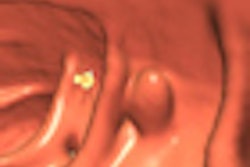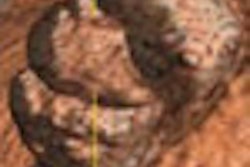Phospho-soda garnered high marks among three different bowel preparations used for the American College of Radiology Imaging Network (ACRIN) 6664 CT colonography trial. However, the prep isn't indicated for all patients, and no prep increased sensitivity, researchers reported in the May American Journal of Roentgenology.
Virtual colonoscopy (also known as CT colonography or CTC) can be performed following a variety of different bowel cleaning preparations with myriad protocols that vary the timing and ingredients. Some providers minimize the prep in hopes of improving the patient experience. Each prep protocol has its advantages and disadvantages, and the results depend to some extent on the patient.
"Some practices prefer [polyethylene glycol (PEG)] because it can be safely used in most patients, unlike Phospho-soda or magnesium citrate, which are contraindicated in some patients," wrote Dr. Amy Hara from the Mayo Clinic in Tucson, AZ, who worked with colleagues from several other U.S. centers. "Others prefer Phospho-soda or magnesium citrate because of higher patient acceptability of Phospho-soda and lower required volumes" (AJR, May 2011, Vol. 196:5, pp. 1076-1082).
On the other hand, recent studies showing a risk of nephrocalcinosis and renal failure in patients ingesting the double-dose Phospho-soda have dampened its popularity. And direct comparisons of the three agents are lacking in the literature. In the current study, the researchers sought to compare the effects of the different full-laxative preparations on patient compliance, residual stool and fluid, reader confidence, and polyp detection at VC.
The study examined a total of 2,525 patients using one of three bowel preparations with bisacodyl tablets and stool and fluid tagging. Patients were instructed to stay on a clear liquid diet the day before the CTC examination. Stool tagging consisted of a minimum of 15 g of liquid barium sulfate administered in three divided doses at mealtimes the day before the examination, with 14 of 15 sites using Tagitol V (Bracco Diagnostics) given in three aliquots: 10 mL at breakfast, 10 mL at lunch, and 30 mL at dinner.
The bowel cleansing regimen consisted of one of the following formulas:
- 4 L of PEG
- 90 mL of Phospho-soda
- 300 mL of magnesium citrate
Patients reported the percentage of their compliance with the prep regimen; for example, whether they consumed the barium agent and oral contrast as directed, didn't take it as directed but fully or partially consumed it, and so on.
Radiologists graded each CTC examination for the amount of residual fluid and stool on a scale from 1 (none) to 4 (nondiagnostic). Reader confidence for true-positive findings was reported on a five-point scale: 1 (low) to 5 (high). Sensitivity and specificity for detecting polyps 6 mm and larger and 1 cm and larger, as compared with colonoscopy, were calculated for each preparation.
After cleansing and bowel insufflation with CO2 (ProtoCO2l, Bracco), the subjects underwent prone and supine virtual colonoscopy on a 16-detector-row or 64-detector-row CT scanner using collimation from 0.5 to 1.0 mm, reconstructions of 1 to 1.25 mm at 0.8-mm intervals, 50 effective mAs, and peak voltage of 120 kV. Glucagon was administered as an antispasmodic before the exam. Same-day optical colonoscopy was performed on all patients.
According to the results, the most commonly prescribed preparation was Phospho-soda (n = 1,403), followed by PEG (n = 1,020) and magnesium citrate (n = 102).
Phospho-soda had the highest patient compliance (p = 0.01), least residual stool (p < 0.001), and highest reader confidence versus PEG for examinations with polyps (p = 0.06).
Magnesium citrate had significantly more residual fluid compared with PEG and Phospho-soda (p = 0.006). The sensitivity and specificity for detecting colon polyps ≥ 6 mm and ≥ 1 cm did not differ significantly between preparations.
Patient preparation compliance and quality scores for three preparations
|
||||||||||||||||||||||||||||||||||||||||||||
| PEG and Phospho-soda were nearly twice as likely to have less residual fluid than magnesium citrate (p < 0.01). PEG and magnesium citrate were more than twice as likely to have more residual stool than Phospho-soda (p < 0.01). Table reproduced with permission from AJR, May 2011, Vol. 196:5, pp. 1076-1082. | ||||||||||||||||||||||||||||||||||||||||||||
Colonoscopy-proven cases with polyps ≥ 1 cm were found in the following number of cases per preparation: 43 with PEG, 52 with Phospho-soda, and 14 with magnesium citrate. For polyps ≥ 6 mm, there were 83 colonoscopy-proven cases with PEG, 102 with Phospho-soda, and 25 with magnesium citrate.
For polyps 1 cm and larger, sensitivity was 90% or higher and specificity was between 87% and 89% for all three preps. There were too few positive cases (n = 14) with magnesium citrate to allow a direct comparison of magnesium citrate with Phospho-soda and PEG, the authors noted.
"The reader-averaged sensitivity and specificity for correctly identifying cases with colon polyps ≥ 1 cm did not differ significantly between preparations," Hara and colleagues wrote. In addition, confidence scores compared by the different preps did not differ significantly when evaluating both positive and negative examinations.
The different formulae in the preparations help explain the relative advantages and disadvantages for each patient.
"PEG is an osmotically balanced electrolyte lavage solution, which results in minimal water and electrolyte absorption and secretion," the authors wrote. "Because PEG does not result in internal fluid shifts, it has the advantage of being safe in the vast majority of patients and provides a gentle colonic lavage."
Phospho-soda is often better tolerated than PEG "primarily because of the lower ingested volume," they wrote. However, the hyperosmotic solution draws "fluid into the bowel lumen and can result in electrolyte imbalances. In addition, Phospho-soda preparations have been shown to induce nephrocalcinosis with hypercalcemia, leading to acute renal failure even in patients with previously normal calcium levels."
Phospho-soda is contraindicated in patients at risk of dehydration, older than 55 years, or who have an underlying risk of renal dysfunction, and the U.S. Food and Drug Administration (FDA) now requires warnings for products using the double (90 mL) dose, Hara and colleagues noted.
Magnesium citrate, a hyperosmotic saline laxative, "increases intraluminal volume, thereby increasing motility," the authors wrote. "It is also thought to stimulate cholecystokinin, promoting fluid secretion and bowel peristalsis."
However, it must be used carefully in patients with renal disease, they added. Magnesium citrate also produced the largest amount of residual fluid, even though less was ingested compared to PEG.
The study showed high patient compliance -- usually the most challenging aspect of the prep -- with greater than 90% compliance and 90% to 100% of patients ingesting at least some of the tagging and iodinated contrast agents.
PEG had the lowest compliance, the group wrote, probably owing to the higher volumes to be ingested. However, PEG and Phospho-soda had "nearly identical" amounts of residual colonic fluid owing to the use of bisacodyl laxative after PEG.
Magnesium citrate was difficult to evaluate because only 100 patients (4%) used it, and most of the studies were interpreted by a single reader. More residual stool was seen versus Phospho-soda (16.7% of segments versus 10.6%), but only 6% of segments had "moderate" amounts of stool or more with this agent.
"Our study indicates that although higher patient compliance, less residual stool, and higher reader confidence were found with Phospho-soda, ultimately PEG and Phospho-soda perform similarly in terms of polyp detection," the group concluded.
However, compliance, confidence, and residual stool do not always conform to reader performance, highlighting the need to assess reader performance when evaluating future studies.




















